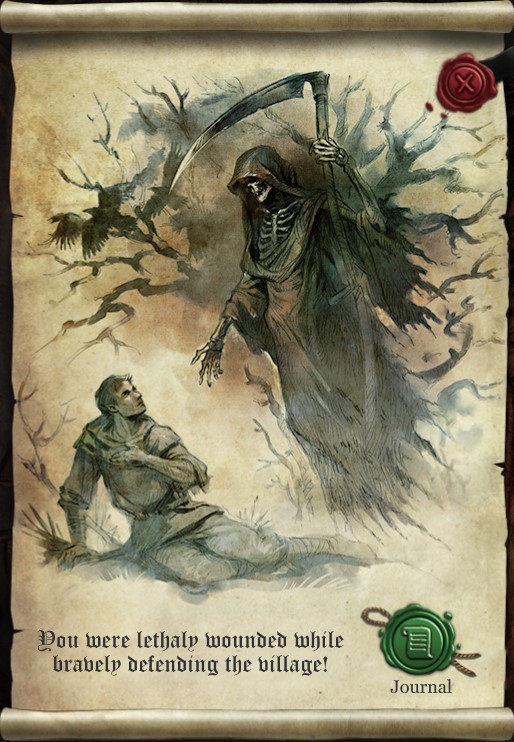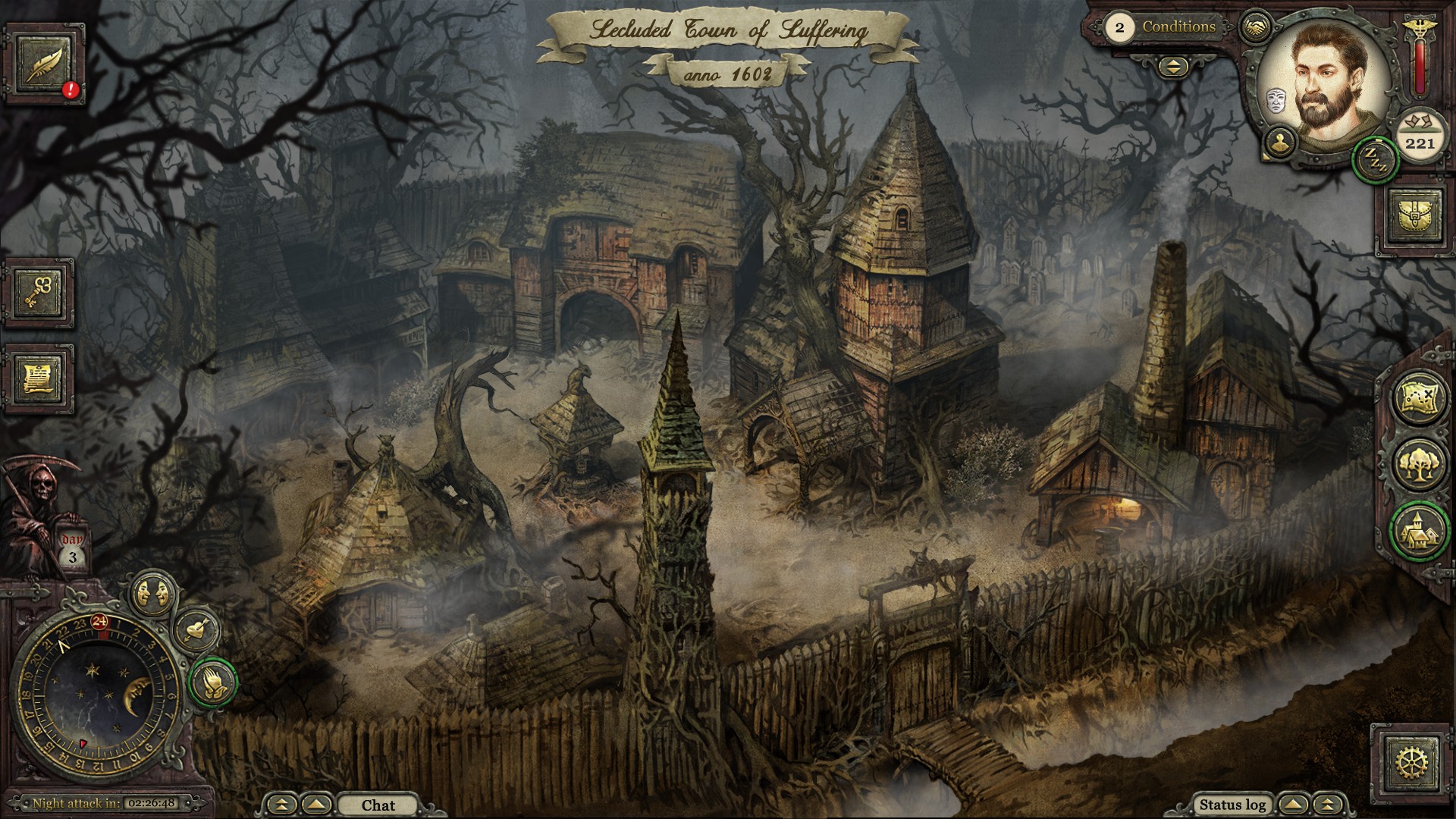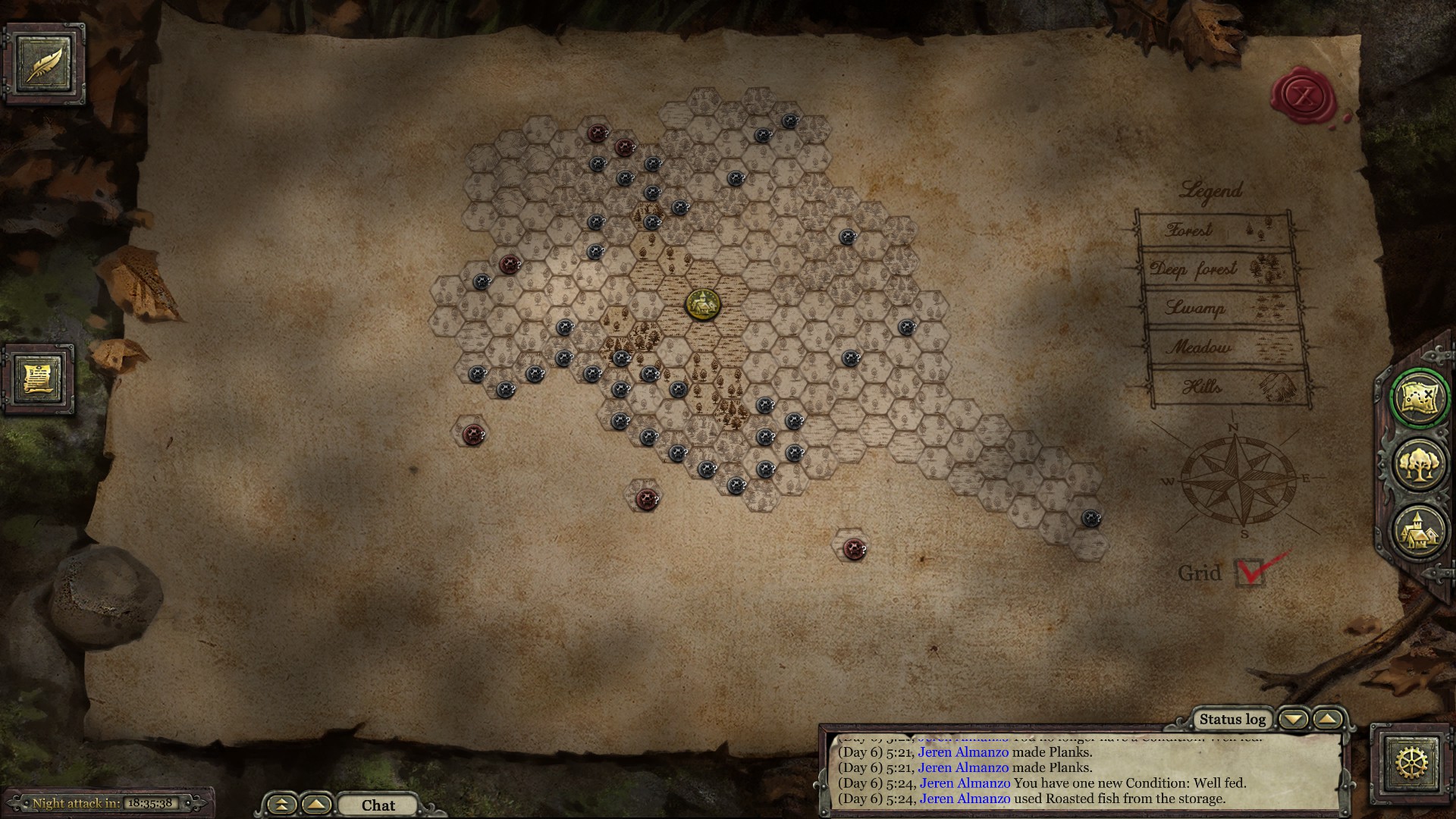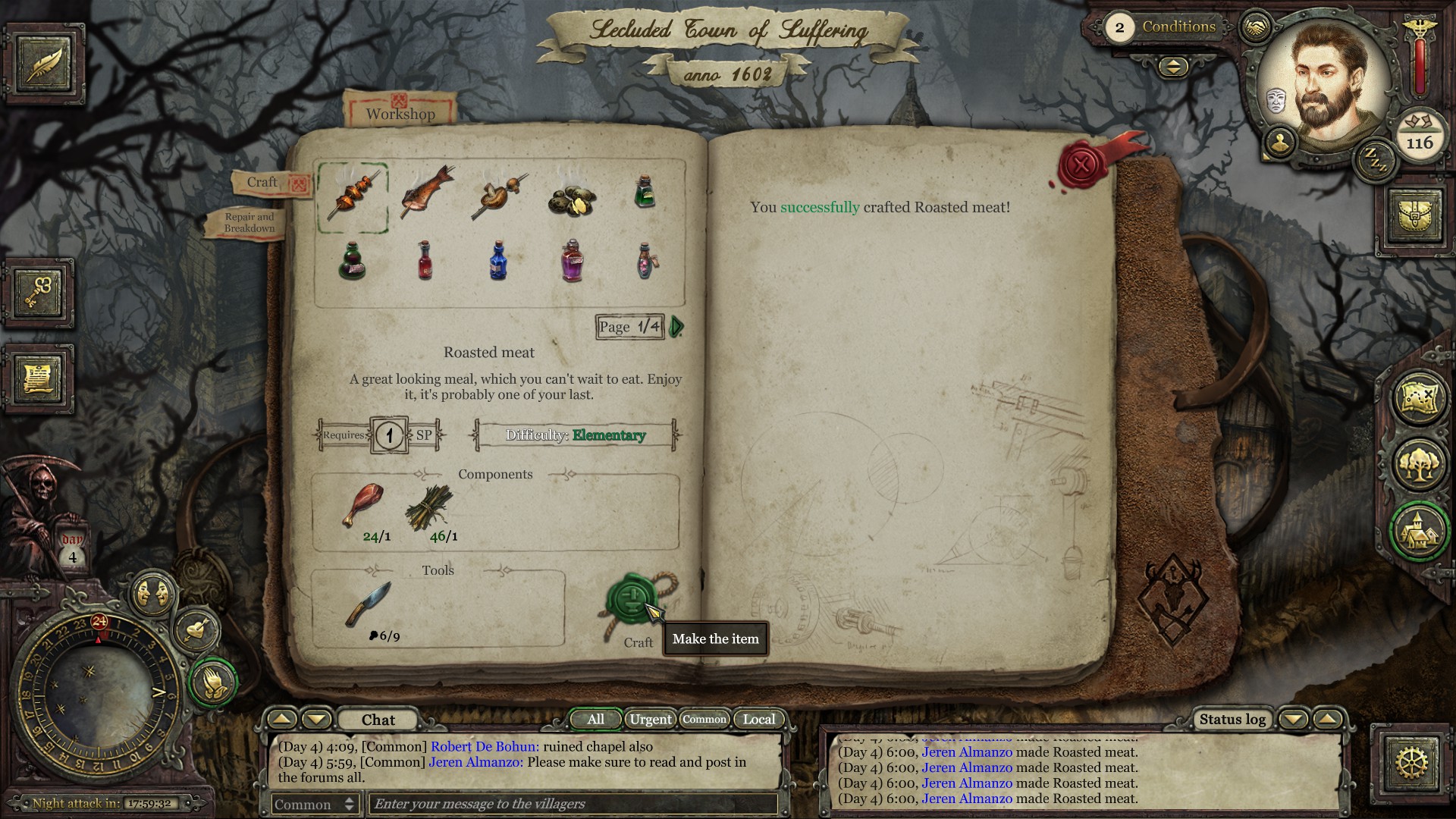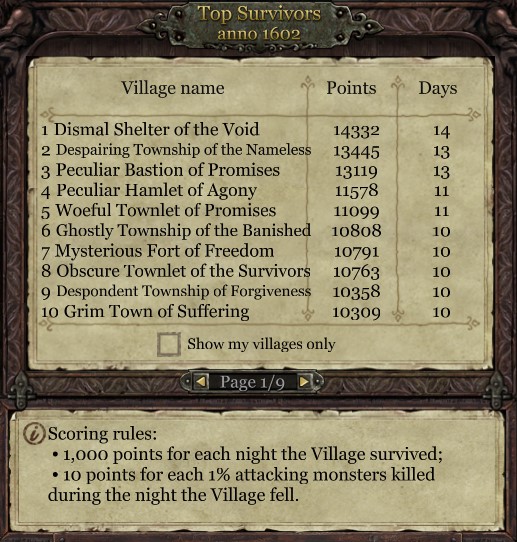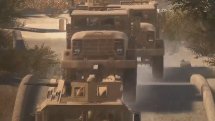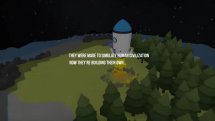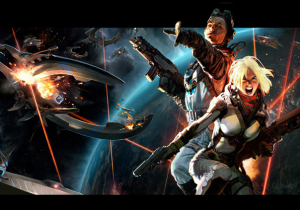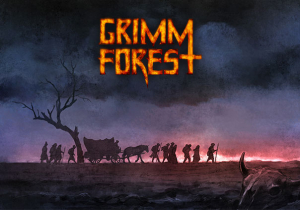GrimmWood – They Come At Night Review
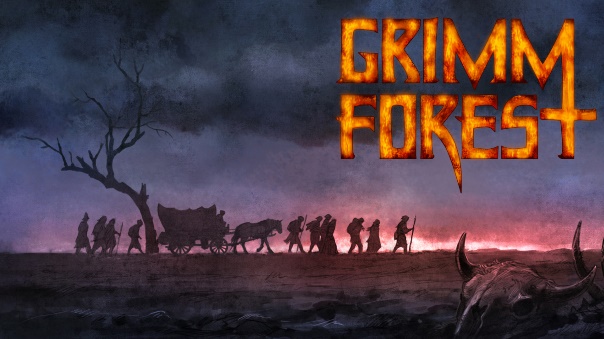
No matter how well designed a game is, or how brilliantly planned; no matter how fine the art is, or unique the style; no matter how well executed a game’s core precepts are, there is always that one thing that no developer is ever going to be able to fully contend with: Human nature. This is most especially true when you’re designing an online game, and exponentially more true when you’re asking for groups of unfamiliar human beings to work together towards a common goal.
All of this is quite the shame because on the surface GrimmWood -They Come at Night really is a fascinating and well put together bit of software. The art style is very dark and foreboding. Leafless trees that look like nightmarish treants stretching across your window shades to infiltrate your bedroom whilst you sleep. That kind of thing. The story is minimal, and comes in the form of a prologue really: There’s a great war, people and animals turn into monsters; you, your kith, and your kin decide to vacate to the forest. You get there though and the forest doesn’t like you either. So you set up in this little village, build a wall (the gray dwarves didn’t pay for it) and try to survive. Try being the key word here. There is no winning at GrimmWood, only surviving the longest.
GrimmWood has two modes: standard and blitz. In standard mode each game day happens in real time. One day in GrimmWood is equivalent to one day in real life. In blitz mode, each day happens in fifteen minutes. Average number of days in a game runs from six to ten days. As of writing this article the longest a village has survived, in blitz mode, was seventeen days. In standard the record is just fourteen days.
That means six to ten days of commitment in a standard game, on average. That longest blitz game ran three hours and forty-five minutes. Given the nature of blitz mode games this would be pretty intense. You don’t get a lot of time to use all of your stamina, and not using all of your stamina in blitz is a bad thing. The other main difference between blitz and standard mode is the number of players in the village. For a blitz game the maximum is ten, and for standard it is forty. After the fifth day, no new players may join to replace those who are deceased.
The game revolves largely around the day cycle. Every day at a specified time the village is attacked. The base strength of the attacks grows progressively stronger every day. Every villager has a set number of stamina points. Stamina points replenish at set rates. I asked if anyone knew what the exact rate was but received no answer. I believe it is one point per fifteen minutes in standard. In blitz it would have to be much much faster. I believe it’s actually one every ten seconds. This is in ideal resting conditions, with a bedroll, and without the thirsty or hungry conditions applied to your character.
There’s a whole list of different conditions your character can have, which I won’t get into at length here because that’s part of the fun of learning the game. Thirsty is one that is the most likely to get you dead though. You want to drink water immediately when you return to town, and first thing any time you log on. In blitz mode you’ll want to drink every day right after the attack and probably more than once after that.
Let’s return to stamina. Why is stamina so important? Because doing anything in the game requires stamina. The only exceptions are drinking from the well, and eating food, or moving items in and out of storage. Eating will actually replenish stamina so it really wouldn’t make too much sense to charge stamina to eat.
The average day in the game goes something along these lines: First off, drink. Next make sure you don’t have the hungry condition. If you do, eat food. After you’re set, visit the storage or workshop to see what supplies your town needs. Knowing what the town needs will come with experience. A safe bet though, especially early, is that you’re going to need darkwood and lightwood in order to increase your village’s defenses. To obtain these, you have to go out into the big scary woods. If you don’t need supplies, then you can spend your stamina building the town’s defenses.
Nobody knows how far you’ll go. Be like Moana.
This is where the other half of the game is played. Outside of the village, each tile has different resources or encounters, generally called points-of-interest, or just P.O.I.s. Traveling from tile to tile costs resources. Using your scout function also costs resources, as does setting up a camp. Initially you only know the number of P.O.I.s in a given tile. Once the tile is scouted, then you know what those P.O.I.s are. You might find a cache of lost goodies, or a hunting ground. You might find a pond which can be fished, or a forest of whitewood or darkwood from which to gather firewood and timber that can be processed into usable materials. Whatever it is you find, it’s almost certainly going to require… you guessed it: stamina!
So, you’ve gathered your darkwood. Now the darkwood probably needs to be chopped into pillars, for defenses. This is done in the workshop. All of the processing of resources from one or two things into something else is done in the workshop. There are traits that can help with crafting, or other things, that you obtain at character creation. I’ll touch on those more later, as they’re something of a point of contention and need to come under the community subject.
Any time you’re given Roasted meat, don’t ask what kind of meat it is. You probably don’t want to know.
I mentioned scouting earlier. This is something everyone is expected to do for multiple reasons. The first person who scouts every day will reveal what the attack strength of the forest is for that day, within a range. More people scouting will narrow the number down. If you get enough people scouting, eventually it will reveal monster lairs on the map. This is important because attacking a lair, or even monsters on the overland map, will reduce the attack strength that night. Survival of the village isn’t just about having a greater defense, it’s about reducing the attack strength before the attack. The importance of this cannot be understated.
Now, this is all a lot of stuff. You simply will not have enough stamina to do all of it. Not even close. Remember, this is a game designed for either ten or forty players. Cooperation is an integral function of the game. It is simply not optional. This too will come up more under the community subject, later. The important thing though is to strive for communication. In standard games, this is done a couple ways. You can try throwing a chat out if there are other people online, and you need something immediate.
It’s going to be critical that the in-game “town forum” is used, at least in standard games. It allows you to coordinate raids on a lair, for example. Or you could tell people when a specific point of interest, such as a darkwood forest, has been used up, and save them from wasting critical stamina visiting that P.O.I.. Or perhaps your character cannot carry much at once, so you’ve left a pile of resources on the map for someone to bring back who has the “Strong” trait. These are the barest few examples of literally dozens and dozens of things which need to be communicated between players to extend the game to its full potential. In blitz mode the chat function generally works pretty well. Since a day is played in 15 minutes less people make use of the asynchronous gameplay style than in standard mode. Still, the forum can be pretty useful for things like expired nodes. Some people form up groups on the official Discord then make a sub-discord for Blitz games so they can communicate in real time using voice.
All of this makes for a really stellar game. You’ve got strategy aspects. You have asynchronous gameplay allowing you to contribute to your village whenever the time suits you, instead of having to stick to strict time zone or sleep schedule strictures. There are lots of cool features and just a very uniquely dark artistic style. Enter the greatest anomaly to programmers: Human nature..
First of all let’s talk about communication. You got that it’s super important, right? So what happens when someone logs in that only speaks Russian? Or maybe French? One guy said he thought he recognized some obscure dialect of Ongota (okay not really, but it was some other uncommon regional language). GrimmWood has no server or region differentiation. If someone in German buys it and hops on they better be good with Google Translate because otherwise the language barrier becomes very obtrusive. I asked the developers if there was any plan on using even a keyword computer-aided-translator and I was more or less told that was way too difficult to even consider bothering with, in a very unprofessional way. So don’t plan on seeing any alleviation to that issue pretty much ever.
Next let me touch on character generation. For both blitz and standard modes when you select a server you’re on that server until you die. You can play one standard mode and one blitz mode game at a time. The only way to leave that game is by being killed, or committing suicide – this involves intentionally being killed by a monster. Unfortunately, this has the effect of causing a loss of sanity to the survivors. In fact, it seems that some groups find it funny on day five to join a server and suicide, just to break the game for other people. Because of human nature.
Once you select your server you get to roll your character. Everything about them is random except gender. you choose to be male or female. You may then roll randomly for their appearance, for which you have unlimited rolls. Finally, you have your traits and your starting equipment. Here’s where it gets tricky.
You see, you only get ten rerolls per server to get the traits and gear that you want. Most people are more focused on the traits, as gear can be acquired in the game. Some starting stuff is nice to have, like maybe a good saw, but people share tools so it’s not the end of the world. On the other hand, traits you can have up to three, two positive and one negative. Sometimes you will end up with just two traits in a roll, which can be one plus one minus, or two beneficial traits. I’ve never personally seen two negative traits. These are the traits you will have the rest of the game. Now, all this is part of the game design. The foundational premise is that you take this randomly generated character, and you do your best with it. The same as the other nine or thirty-nine players on your server.
What’s wrong with that? Human nature. It was my experience that people who rolled their ten dice rolls, then didn’t like their tenth one, and didn’t get the “meta” roll, decided that it wasn’t worth playing the game. They would suicide their character, causing a sanity hit to the rest of the village. You see, some people just can’t accept not being a superhero. I’m not going to get into speculations about their mental shortcomings. I’m just going to say that they have an attitude of, “Well, the devs don’t punish me for doing this thing, so I’m going to do it, no matter who else it hurts, because I’m the only one that matters, and if you don’t choose to do this, you’re hindering yourself, and are thus inferior.” Another player said that “it’s the devs fault. They made it so that in order for me to be competitive, I have to play this way.”
Perhaps they’re right. I don’t know, but what I do know, is that it breaks the game. Even in a blitz game, if you had ten friendly players, how likely is it that you’re going to get the ultimate “meta” dice rolls for every character? If you did do that, and you managed to get the high score on the Leaderboards, did you really accomplish anything? Did you play the game as the developers intended and obtain that high score, or did you abuse and exploit the fact that you’re not being punished directly?
And that is what these players want: to be the highest on the leaderboards. These players are so focused on this goal that they do not think they need to be polite or considerate towards other people. If you don’t do things their way, they’ll be rude, insulting, and disruptive towards your gaming experience. Thankfully they’re a minority. Unfortunately this wasn’t an isolated incident, and they’re a very vocal minority. Over the span of time that I’ve been playing the game the Discord has gone virtually silent, because anyone who doesn’t agree with their abusive playstyle (including the devs) is browbeaten into silence. In my opinion it’s like bringing a T-ball stand to a MLB game and then bragging about getting a home run (if bringing the T-ball stand wouldn’t just get you ejected).
That brings my to my final point in regards to community. I think you’re about as likely to get forty random people on the internet to work together and cooperate as you are to herd a thousand cats away from a catnip factory. I mean, I’m not saying it can’t be done, but good luck, and better you than me. The developers have made some noise about assigning some roles to villagers such as a sort of mayor, and a quartermaster. This could help some of the issues I imagine (the quartermaster would be to help with people logging on, taking a bunch of items, and logging off, never to return), but I don’t think it will ever totally overcome human nature.
I think eliminating the Leaderboards, or segregating them into styles of play, would be a great benefit. It would let the diehard players have their game, and the regular nerds have their game. There is also scuttlebutt from the developers about a sort of rating system that would punish players for suiciding, or for getting banished from a village (part of the game’s already existing democratic system). When one of the people I encountered heard this, he said that he would quickly leave the game, and tried to insinuate it would be the death of the game for everyone else (at least until private games were allowed, which the developers have suggested will be unlikely any time soon). People that had high occurrences of bad marks would get grouped with others who had a lot of demerits, and the opposite would also be true. Again, this might help, but it seems like a high amount of demand from the developers to accomplish.
There are so many things I like about GrimmWood – They Come at Night. The ambiance, the premise, the strategy? It’s all really great. Unfortunately, the developers had high hopes for the player-base being responsible considerate adults, and didn’t really give their game tools to mitigate those who did not fall under that category.
Until those systems are in place, this game really isn’t worth playing with anything but the most casual consideration. None of this even taking into account the state of the game’s bugs, which combined with its lacking features make it feel more like an early access title. As such, my current recommendation is to follow the game, or perhaps add it to your wishlist. Watch the news for updates and patches, and see if they address any of these issues. Otherwise, keep your distance.
Final Verdict: Fair (2.5/5)
Articles You May Enjoy
- Red Stone Releases Update Featuring Major Character Balance Changes
- Red Stone Online launched a major update yesterday which offered some major balance changes on five characters, and much more.
- Deathtrap Out Now on Steam Early Access
- Deathtrap Early Access is finally out on Steam for $19.99.


